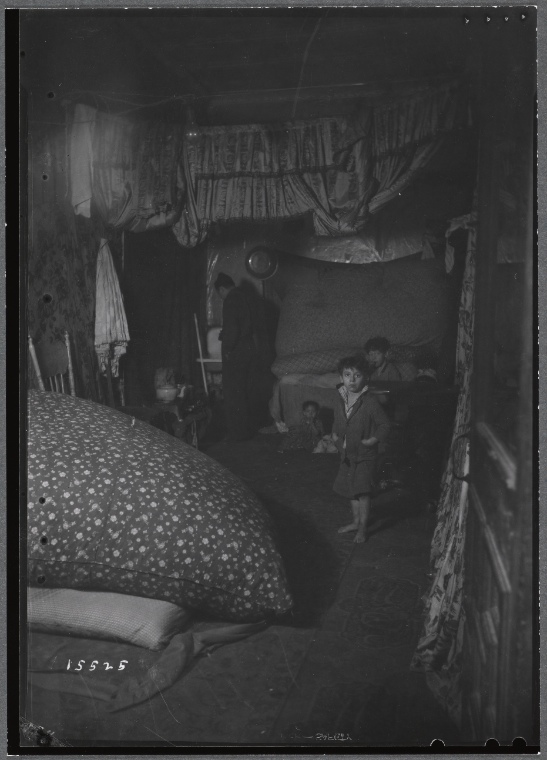Research at NYPL, Doc Chat
Doc Chat Episode Twenty-Seven: Exploring 1930s New York City Through Tenement Photography
On May 6, 2021, Doc Chat explored living conditions in New York City in the 1930s, along with the agencies created to regulate and reform housing.

A weekly series from NYPL's Center for Research in the Humanities, Doc Chat pairs an NYPL curator or specialist and a scholar to discuss evocative digitized items from the Library's collections and brainstorm innovative ways of teaching with them. In Episode Twenty-Seven, NYPL's Carmen Nigro and Annie Polland, President of the Lower East Side Tenement Museum, examined photos taken by inspectors of the New York City Tenement House Department and discussed reform, regulation, and social conditions in Depression-era NYC.
Doc Chat Episode 27: Exploring 1930s New York City through Tenement Photography from The New York Public Library on Vimeo.
A transcript of this event is available here.
Below are some handy links to materials and sources suggested in the episode.
Episode Twenty-Seven: Primary Sources
Carmen and Annie explored Photographs taken by inspectors of the New York City Tenement House Department. Over 4,000 photos were gifted to NYPL by the New York City Department of Housing and Buildings in 1942. Approximately 1,100 are available in Digital Collections today.
Specifically, they analyzed the following photographs:








Episode Twenty-Seven: Secondary Sources
Jared N. Day, Urban Castles: Tenement Housing and Landlord Activism in New York City, 1890-1943 (Columbia University Press, 1999).
Patrick Deane, ed. History in Our Hands: A Critical Anthology of Writings on Literature, Culture, and Politics From the 1930s (Leicester University Press, 1998).
Andrew Dolkart, Biography of a Tenement House: An Architectural History of 97 Orchard Street (Center for American Places, 2012).
Federal Writers' Project of the Works Progress Administration in New York City, The WPA Guide to New York City: The Federal Writers' Project Guide to 1930s New York (Pantheon Books, 1982).
David E. Kyvig, Daily Life in the United States, 1920-1940: How Americans Lived through the "Roaring Twenties" and the Great Depression (Ivan R. Dee, 2004).
Edward Lubitz, The Tenement Problem in New York City and the Movement For Its Reform, 1856-1867 (New York University, 1970).
Robert S. McElvaine, The Depression and New Deal: A History in Documents (Oxford University Press, 2000).
Dorothy Laager Miller, New York City in the Great Depression: Sheltering the Homeless (Arcadia, 2009).
Michael Shally-Jensen, ed., The 1930s (1930-1939) (Grey House Publishing, 2014).
Jules Stewart, Gotham Rising: New York in the 1930s (Tauris, 2016).
Peter Walther, New Deal Photography: USA 1935-1943 (Taschen, 2016).
Episode Twenty-Seven: Additional Resources
For an in-depth exploration of tenements and the resources available at NYPL for researching this history, see Carmen Nigro, "Tenement Homes: The Outsized Legacy of New York's Notoriously Cramped Apartments," NYPL Blog, June 7, 2018.
To learn more about document analysis using photographs, explore The National Archives’ Document Analysis Worksheets.
Use NYPL's catalog to research the Works Progress Administration.
Search 1930s census data by address.
Join the Doc Chat Conversation
Doc Chat episodes take place on Zoom every Thursday at 3:30 PM. Check out upcoming episodes on NYPL's calendar, and make sure you don't miss an episode by signing up for NYPL's Research newsletter, which will include links to register. A video of each episode will be posted on the Research Channel of the NYPL blog shortly after the program. There you can also explore videos and resources for past episodes. See you at the next Doc Chat!
Read E-Books with SimplyE
 With your library card, it's easier than ever to choose from more than 300,000 e-books on SimplyE, The New York Public Library's free e-reader app. Gain access to digital resources for all ages, including e-books, audiobooks, databases, and more.
With your library card, it's easier than ever to choose from more than 300,000 e-books on SimplyE, The New York Public Library's free e-reader app. Gain access to digital resources for all ages, including e-books, audiobooks, databases, and more.
If you don’t have an NYPL library card, New York State residents can apply for a digital card online or through SimplyE (available on the App Store or Google Play).
Need more help? Read our guide to using SimplyE.